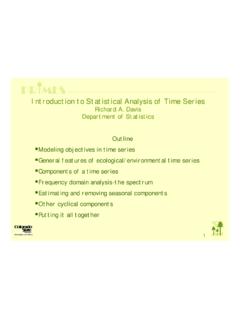Transcription of Forecast for Solar Cycle 25 - breadandbutterscience.com
1 Impact 2018 1 Forecast for Solar Cycle 25 James A. Marusek I. Introduction The sun is the natural source of heat and light for our planet. Without our sun, the earth would be a cold dead planet adrift in space. But the sun is not constant. It changes and these subtle changes affect the Earth s climate and weather. At the end of Solar Cycle 23, sunspot activity declined to a level not seen since the year 1913. [Comparing Yearly Mean Total Sunspot Numbers1] The following was observed during the Solar Cycle 24: 1. The number of sunspots over the entire Solar Cycle decreased significantly by 50% or greater. 2. There were fewer Solar flares and coronal mass ejections (CME s), which produces Solar Proton Events (SPE s) and geomagnetic storms on Earth.
2 During the transition, beginning in July 2000, the sun produced 6 massive explosions in rapid succession. Each of these explosions produced Solar proton events with a proton flux greater than 10,000 pfu @ >10 MeV. These occurred in July 2000, November 2000, September 2001, two in November 2001, and a final one in October 2003. And there hasn t been any of this magnitude 3. The magnetic field exerted by the sun significantly weakened. The Average Magnetic Planetary Index (Ap index) is a proxy measurement for the intensity of Solar magnetic activity as it alters the geomagnetic field on Earth. It has been referred to as the common yardstick for Solar magnetic activity.
3 Ap index measurements began in January 1932. The quieter the sun is magnetically, the smaller the Ap index. During the 822 months between January 1932 and June 2000, only one month had an average Ap index that dropped down to 4. But during the 186 months between July 2000 and December 2015, the monthly Ap index fell to 4 or lower on 15 4. The number of Galactic Cosmic Rays (GCRs) striking Earth increased. GCRs are high-energy charged particles that originate outside our Solar system. They are produced when a star exhausts its nuclear fuel and explodes into a supernova. The Sun s magnetic field modulates the GCR flux rate on Earth. Cosmic rays are deflected by the interplanetary magnetic field embedded in the Solar wind, and therefore have difficulty reaching the inner Solar system.
4 The effects from the Solar winds are felt at distance approximately 200 AU from the sun, in a region of space known as the Heliosphere. As the sun went quiet magnetically, the Heliosphere shrunk, and a greater number of these particles penetrated into the Earth s atmosphere. The sun's interplanetary magnetic field fell to around 4 nano-Tesla (nT) from a typical value of 6 to 8 nT. The Solar wind pressure went down to a 50-year low. The heliospheric current sheet flattened. In 2009, cosmic ray intensities increased 19% beyond anything that was seen since satellite measurements began 50 years 5. In general, the sun s total irradiance varies about percent over normal Solar cycles.
5 But this variation is not linear across the entire radiation spectrum. Between 2004 and 2007, it was observed that the decrease in ultraviolet radiation (with wavelengths of 400 nanometers) was 4 to 6 times larger than expected, whereas the visible light (400-700 nanometers) showed a slight This is significant because Solar UV flux is a major driver of stratospheric chemistry. 6. The upper atmosphere of Earth collapsed. The thermosphere ranges in altitude from 90 km to 600+ km above the Earth s surface. During the depth of last Solar minimum in 2008-2009, Impact 2018 2 the thermosphere contracted by the largest amount observed in at least the last 43 years.
6 The magnitude of the collapse was two to three times greater than low Solar activity could 7. Solar radio flux during the peak of the Solar Cycle diminished significantly. The index is a measure of the Solar radio flux per unit frequency at a wavelength of cm, near the peak of the observed Solar radio emission. The Solar Cycle minimum produced the lowest flux since recordings began in February 8. Sightings of noctilucent clouds (or night clouds) are appearing at lower latitudes. These clouds are formed from ice crystals in the extreme upper atmosphere, called the mesosphere. Noctilucent clouds (NLCs) were first reported by Europeans in the late 1800s.
7 In those days, you had to travel to latitudes well above 50 to see them. Now, however, NLCs are spreading. In recent years they have been sighted as far south as Colorado and Utah in the United States. II. Background - Solar Cycles sunspots are dark spots that appear on the surface of the sun. They are the location of intense magnetic activity and they are the sites of very violent explosions that produce Solar storms. The sun goes through a Cycle lasting approximately 11 years. It starts at a Solar minimum when there are very few sunspots and builds to a Solar maximum when hundreds of sunspots are present on the surface of the sun and then returns back to a Solar quiet minimum.
8 This Cycle is called a Solar Cycle . We are currently in the Solar minimum separating Solar Cycle 24 and 25. The first Solar Cycle documented by scientist began in March 1755. Figure 1. Image of Solar Cycle 23 from the Solar and Heliospheric Observatory (SOHO) by Steele Hill (NASA GSFC) Impact 2018 3 The sun exhibits great variability in the strength of each Solar Cycle . Some Solar cycles produce a high number of sunspots . Other Solar cycles produce low numbers. When a group of cycles occur together with high number of sunspots , this is referred to as a Solar Grand Maxima. When a group of cycles occur with minimal sunspots , this is referred to as a Solar Grand Minima.
9 Usoskin details the reconstruction of Solar activity during the Holocene period from 10,000 to the Refer to Figure 2. The red areas on the graph denote energetic Solar Grand Maxima states. The blue areas denote quiet Solar Grand Minima states. The reconstructions indicate that the overall level of Solar activity observed in the middle of the 20th century stands amongst the highest of the past 10,000 years. The 20th century produced a very strong Solar Grand Maxima. Typically these Grand Maxima s are short-lived lasting in the order of 50 years. The reconstruction also reveals Grand Minima epochs of suppressed activity, of varying durations have occurred repeatedly over that time span.
10 A Solar Grand Minima is defined as a period when the (smoothed) sunspot number is less than 15 during at least two consecutive decades. The sun spends about 17 percent of the time in a Grand Minima state. Examples of recent extremely quiet Solar Grand Minima are the Maunder Minimum (about 1645-1715 ) and Sp rer Minimum (about 1420-1570 ) Figure 2. Sunspot activity throughout the Holocene. Blue and red areas denote grand minima and maxima, respectively. The entire series is spread out over two panels for better The sun has undergoing a state change. It transitioned from a Grand Solar Maxima, which typified the 20th century to a magnetically quiet Solar period similar to a Dalton Minimum.






